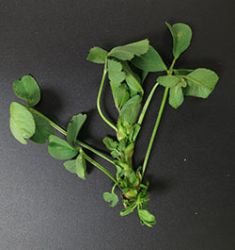
Stunted alfalfa plants with shortened internodes and white plant tissue are telltale signs that alfalfa stem nematode may be a problem.
In a recent University of California extension Alfalfa & Forage News blog, Michelle Leinfelder-Miles noted that stem nematode symptoms are starting to be seen by crop consultants in her region. Leinfelder-Miles, an extension farm adviser based out of Stockton, notes that the alfalfa stem nematode is especially a problem in the spring when temperatures are cooler.
“The nematodes are microscopic roundworms that use their stylet, or needle-like mouthpart, to puncture plant cells and suck out their contents. The alfalfa stem nematode lives and feeds in the stems and crown of the plant,” says Leinfelder-Miles. “It’s not a particularly easy pest to manage and, where present, will cause complete plant dieback.”
There are alfalfa varieties with varying levels of resistance, but even highly resistant varieties have a percentage of individual plants that are susceptible. Nevertheless, Leinfelder-Miles still suggests planting nothing but varieties with high resistance where the pest is a known problem.
The alfalfa stem nematode can be spread by infected seed, field equipment, wastewater, and by manure from cattle that have consumed infected hay.
“Because of its limited host range, crop rotation is another good option to mitigate stem nematode problems,” says Leinfelder-Miles. She suggests staying out of alfalfa at least two years, but notes that longer rotations might be needed for severe infestations. Possible nonhost rotation crops might include small grains, corn, or dry beans.
For additional information on alfalfa stem nematode, see this recent article that appeared in Hay & Forage Grower.

